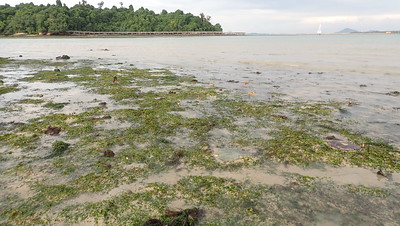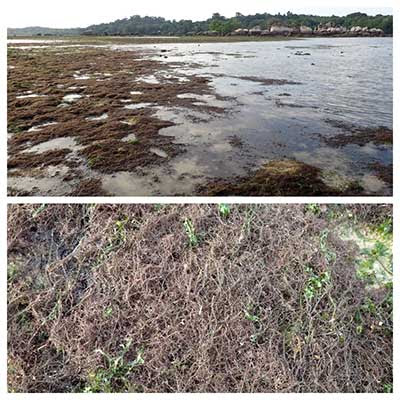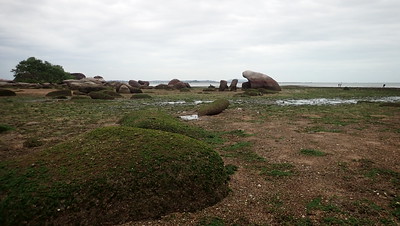 |
| The 'arm' around the lagoon at Pulau Sekudu is only exposed at very low tides. |
Pulau Sekudu is very close to Chek Jawa on Pulau Ubin, and is part of Chek Jawa Wetlands. Today, we saw a lot more sponges, compared to the survey with just me and Chay Hoon (due to COVID restrictions) in Jul 2021.
 |
| A sponge covered rock with Chek Jawa on the horizon. |
It was good to see large Knobbly sea stars on the arm of the lagoon, similar to what I saw in Jul 2021. I saw about 10 of them. Unfortunately, we didn't come across any Biscuit sea star, which have been missing from Pulau Sekudu since Jul 2020. These are usually so abundant, so it is worrying to not come across any. I saw Garlic bread sea cucumbers, Orange sea cucumbers, Thorny sea cucumber, Pink warty sea cucumber and Big synaptid sea cucumbers. But no other echinoderms.
I also saw a few small Boulder pore corals colonies on the arm of the lagoon. They were all nice and brown (not bleaching) and well formed without dead patches. The most abundant cnidarians were Haddon's carpet anemones and Swimming anemones. I saw a few other individual cnidarians like Flowery sea pen, cerianthids, one sea fan, a few flowery soft corals and one brown Glass anemone.
Kok Sheng saw a live Ramose murex, which we had seen in 2019. This snail listed as 'Endangered' on the Red List of threatened animals of Singapore.
Chay Hoon also saw the Long spined black sea urchin: good to know it's still there
It was good to see the patch of Serrated ribbon seagrass still covering a good area opposite Chek Jawa was still doing well. But I only saw small patches of Fern seagrass. And I noticed small patches of Spoon seagrasses near the Frog Rock was bleaching.
There was one large clump of Tape seagrass with long leaves and male flower bracts. And also two patches with very short cropped leaves.
I looked and couldn't find many furrows that looked like dugong feeding trails. There were only a few that looked old. This is similar to the situation I saw on Chek Jawa yesterday.
There is still a bloom of Hypnea red seaweed on the arm of the lagoon, similar to what I saw in Jul 2021.
Egrets are starting to nest on the small mangrove trees growing at the top of the island. The first time I've noticed them here.
One of the boulders on the island resembles a frog and indeed Pulau Sekudu is also called Frog Island. It is part of the legend of how the islands of Sekudu and Ubin were formed when an Elephant, a Pig and a Frog challenged one another to a race from Singapore to Johor.
Someone had helpfully added a smile and some eyes to the Frog Rock. Pulau Sekudu is off limits since 2007 and requires special permission from NParks. Thanks to NParks for permission and support to do these predawn low spring tide surveys of the island.
What is the fate of Pulau Sekudu?
The 2013 landuse plan by the Ministry of National Development released in response to 2013 Population White Paper shows plans for 'possible future reclamation' (in light blue surrounded by dotted lines) that may impact Chek Jawa and Pulau Sekudu.
The plan includes plans for a road link (black line) from the mainland jumping off at Punggol, crossing to Pulau Ubin through Chek Jawa to jump off to Pulau Tekong before circling back to the mainland on Changi East. Proposed reclamation (in yellow) will bury Pasir Ris shores, Pulau Sekudu and Chek Jawa as well as a large amount of shore at Changi Beach. I feel it is thus important to update our understanding of what is going on in the field at these sites including Chek Jawa and Pulau Sekudu.
The Singapore Blue Plan 2018
Among the Proposed Areas for Immediate Conservation Priority, the Singapore Blue Plan 2018 proposes that the intertidal and subtidal marine areas of Pulau Ubin to be designated Marine Reserve.
The proposed area would include Tanjung Chek Jawa, the largest known intertidal area in northern Singapore. Considered one of the richest in Singapore, Chek Jawa comprises many adjacent ecosystems: coastal hill forest, mangrove areas, rocky shores, seagrass meadows, coral communities, and sandy areas. Chek Jawa remains an icon of celebration and hope for many Singaporeans since its reprieve from reclamation in 2001.
Much of the remaining coastal areas around Pulau Ubin are mangrove areas. Protecting these can be impactful due to the relatively large interconnected areas. Already, a community-driven project, Restore Ubin Mangroves (R.U.M.) Initiative, is in place to rehabilitate mangrove areas previously converted to fish and shrimp farms. These areas also offer hope for the recovery of the smallclawed otter population.
DOWNLOAD the Plan, SUPPORT the Plan! More on the Singapore Blue Plan 2018 site.
We enjoyed a lovely sunset over Pulau Sekudu on our survey. Let's hope the island will see many more.
Photos by others on the survey
Loh Kok Sheng
Jianlin Liu
Chay Hoon
Vincent Choo













